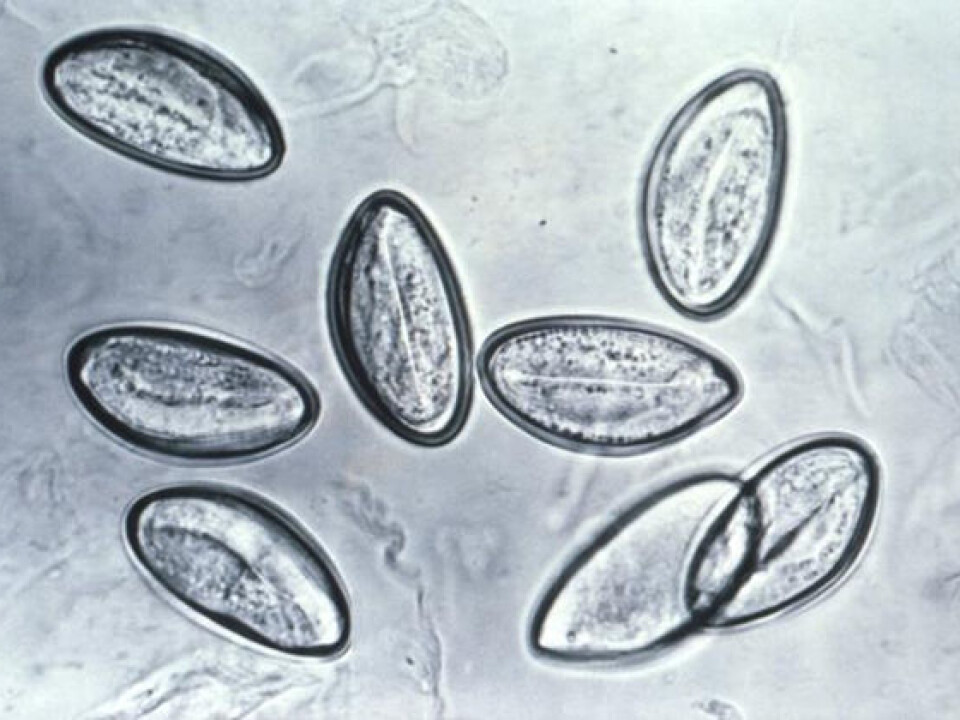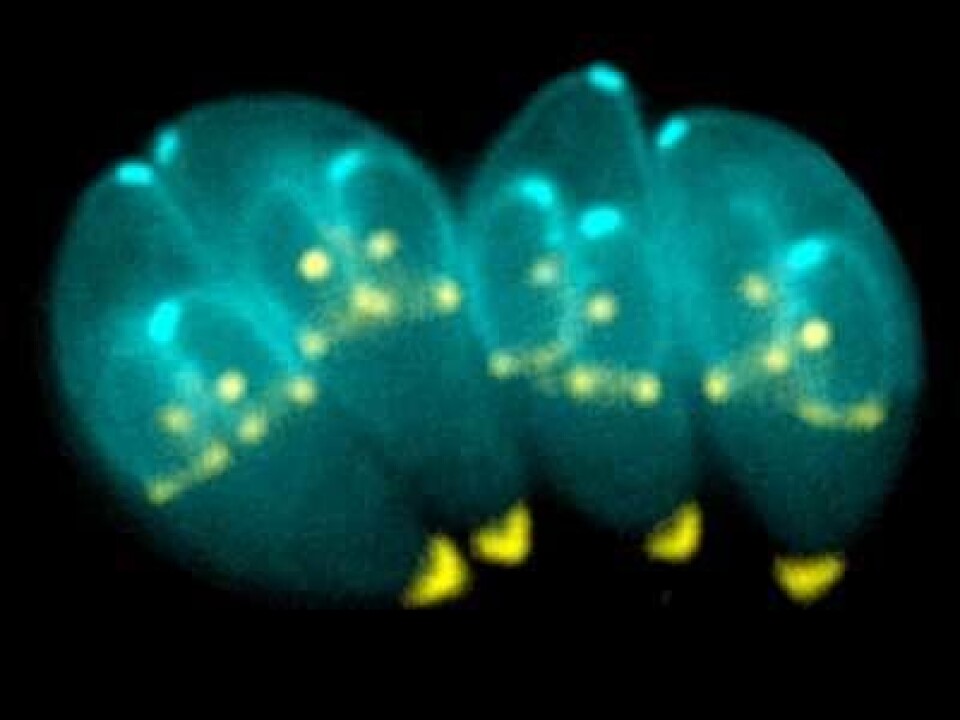
Microbe masters
Viruses, bacteria and parasites make us sneeze, poop or scratch our behinds. Can they also be behind some of the world’s major cultural differences?
Denne artikkelen er over ti år gammel og kan inneholde utdatert informasjon.
Over half the species on the planet live on or inside other organisms. Countless bacteria are active inside our bodies, sometimes keeping company with viruses, fungi, worms and other tiny organisms.
Many of these stowaways are useful or even vital for those who carry them. Others live relatively sedate lives, not making much difference one way or another. Then there are the hostile types, some of whom even viciously murder their hosts.
Microbes that make their hosts ill are often subjected to counter-attacks. They’re faced with a major challenge: how to spread to new hosts before being wiped out by the present one, or getting too far ahead and killing it?
Understandably, the parasites that have survived and thrived are the ones that have evolved smart tricks. Now and then enhancing mutations occur and these get passed on.

But many of these tricks involve getting us – the hosts – to do our part in helping out.
Cough, gurgle, at-choo!
We’re over-familiar with some of the common examples. Surely you don’t think it’s simply a matter of chance that the viruses and bacteria causing colds congregate in your mucus membranes?
Irritation gets mucus production running full throttle. An irritation or itch triggers a cough or sneeze, and we spray a mist of microscopic, infested droplets.
Or what about the viruses that cause gastric flu, and their associates among bacteria − Vibrio cholerae – better known as cholera?

They change one of our normal body functions into an uncontrolled sprinkler system for spreading infected faeces. Cholera bacteria can actually kill a person in hours due to dehydration.
A less terrifying example is the pinworm (Enterobius vermicularis), a small and relatively benign worm that resides in human intestines, most commonly in young children who attend daycares. It too tries to irritate us into doing what it wants, according to Petter Bøckman at the Natural History Museum in Oslo.
“It gathers around near your rectum and vibrates its posterior. It makes the anus itch like crazy and when alleviating that you can get eggs on your fingers and soon contaminate yourself more or contaminate others," says Bøckman.
Common interest
Research also indicates that the malaria parasite makes our bodies more attractive to mosquitoes. A study conducted in 2005 showed that children with the parasite would then become plagued by more mosquitoes than those without it.

But the main tools used by pathogenic microbes are the ones that get us to cough, sneeze or give us diarrhoea, according to Jørgen Lassen, former chief physician at the Department of Food-Borne Infections at the Division of Infectious Disease Control at the Norwegian Institute of Public Health.
In this case both parties have a common interest.
Coughing and diarrhoea both make the host get rid of pathogenic microorganisms and thus act as essential defence mechanisms. At the same time these symptoms contribute to the survival of the microbe through spreading to new hosts – if there are any nearby.
And usually there are.
Simplest is best
“The congregation of lots of people, many potential hosts, is civilisation’s cultural gift to the pathological microbes,” says Lassen.
In a densely populated world the diligent use of hosts, sneezes and excrement make a recipe for success.
The simplest tactics are clearly the best, also for microbes. Placement in areas of the body where no excretions occur is usually an evolutionary dead end.
“The Earth’s history is probably littered with unsuccessful microbes that tried – for instance in muscle tissue or in brain – but ran into insurmountable problems spreading themselves and thus died out,” says Lassen.
Nevertheless a few creatures have not only survived in other organs, but evolved crafty strategies for getting out again. Some of these examples involve direct and terrifying manipulation of animal or human behaviour.
Biting and drooling
“Rabies is the classic example of microbes manipulating behaviour,” says Lassen.
The rabies virus infects the central nervous system and follows the peripheral nerves up to the brain. Once there, it does something, but scientists aren’t sure what. Somehow the rabies virus gets the carrier, whether a dog or a human, to exhibit abnormal behaviour, brought about by symptoms including terror, paranoia and hallucinations.
Infected animals become aggressive and unpredictable and get the uncontrollable urge to bite anything that moves. They simultaneously start a prodigious production of contaminated saliva.
“The virus can only be spread by being directly injected into the bloodstream of the next victim. The aggressive biting and salivation helps to ensure that. The rather mysterious change in the host’s behaviour is a prerequisite for survival of the virus,” says Lassen.
In an essay in Scientific American in 2003 the biologist Robert Sapolsky dejectedly confided that this itsy-bitsy rabies virus seems to know more about the neurological mechanisms behind aggression than all the neurologists in the world.
Amazing precision is required to get such an effect on something as complicated as a mammalian brain. Still, we know of another microscopic critter that has learned an even more impressive trick.
Just love that cat
The single-celled parasite Toxoplasma gondii gets rats to like cats.
This microbe can only reproduce sexually in the stomachs of cats, but they can also infect muscles and organs of a number of other creatures, such as sheep and human beings. But perhaps the most common animals to get infected are rats and other rodents in the neighbourhood.
Then the challenge for this parasite is: how do I get back inside the stomach of a cat? As we know, this often works well on its own, because mice or rats are a cat’s natural happy meal.
But T. gondii doesn’t want to waste time waiting for Tabby, and maybe in the meantime ending up in the digestive track of the wrong species. So it enters the rodent’s brain and starts making alterations that tip the odds in its favour.
It’s been known for some time that rats with toxoplasmosis appear to lose their instinctive fear of cats. But a study in 2011 shows that the connection is even more complicated.
Some of the fear can still be there, but the smell of cats’ urine makes male rats behave as if they smell the scent of a female rat in heat. The rodent is sexually attracted to the cat.
Does something in humans too
It’s unclear what this parasite does up in the brains of the people who are infected. Newer research indicates, however, that something is going on.
Even though humans are a dead end for T. gondii – fortunately we aren’t likely to end up inside any cat stomachs. But it can change our behaviour.
Perhaps diverse levels of the little parasite in various populations can explain some of the cultural differences in the world, speculates the ecologist Kevin D. Lafferty at the US Geological Survey.
In 2006 he published research that indicated something along this line.
More neurotic
One of the most prominent effects ever contributed to T. gondii is that those infected tend to be a little more neurotic, says Lafferty in an interview in the programme All in the mind on Australia’s ABC Radio National.
Neurotics can be more reactive and dogmatic, and perhaps more prone to feeling guilty.
“Because toxoplasmosis is a health issue for pregnant women, we have fantastic data on the incidence of this parasite from 40 to 50 countries,” says Lafferty.
“We also have data regarding cultural dimensions and concentrations of personality types. Enormous studies have been made of many, many people to identify differences in culture and personalities from country to country.”
Strong gender roles and aversion to insecurity
"There’s a very strong association between the prevalence of toxoplasmosis and the amounts of neuroses on the national level,” says Lafferty.
This also applied when Western countries were compared to prevalence of the parasite.
According to the psychologist the more neurotic cultures tend to have a more rigid distribution of roles and extra aversion to insecurity. They are more prone to establish political structures that ward off insecurity. Such societies also have more stringent gender roles.
Lafferty emphasizes that the parasite obviously cannot explain all the variations among cultures. It would also be hard to make any certain causal claims without conducting large-scale, impractical if not impossible experiments.
Jørgen Lassen points out that one has to consider what in this instance is the cause and what is the effect. Cultural differences could also have an impact on the prevalence of the parasite. For instance Toxoplasma is more common in areas where less raw meat is eaten than in ones where meat is served thoroughly boiled, baked or fried.
Nevertheless, it’s interesting that toxoplasma explains more of the variations of neuroticism than social science has been able to do using other factors, asserts Lafferty.
This doesn’t mean though that a prospective influence of the parasite needs to be negative, says the researcher, according to the USGS.
“After all, it contributes to cultural diversity.”
Translated by: Glenn Ostling
Scientific links
- R. Lacroix, W. R. Mukabana, L. Clement Gouagna, J. C. Koella, Malaria Infection Increases Attractiveness of Humans to Mosquitoes, PLoS Biology, september 2005.(Abstract)
- Robert Sapolsky, Bugs in the Brain, Scientific American, 10. februar 2003.(Abstract)
- Patrick K. House, Ajai Vyas, Robert Sapolsky, Predator Cat Odors Activate Sexual Arousal Pathways in Brains of Toxoplasma gondii Infected Rats, PLoS ONE, 2011; 6 (8).(Abstract)
- Kevin D Lafferty, Can the common brain parasite, Toxoplasma gondii, influence human culture? Proceedings of the Royal Society B, 7. november 2006, vol 273, nr 1602, s 2749-2755.(Abstract)






























